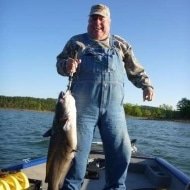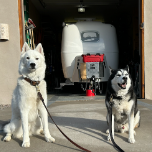-
Posts
730 -
Joined
-
Last visited
-
Days Won
14
routlaw last won the day on August 25 2023
routlaw had the most liked content!
My Info
-
Gender or Couple
Couple
-
Location
Montana
- Website
My RV or Travel Trailer
-
Do you own an Oliver Travel Trailer, other travel trailer or none?
I own an Oliver Travel Trailer
-
Hull #
70
-
Year
2015
-
Make
Oliver
-
Model
Legacy Elite II
-
Floor Plan
Standard Floor Plan
Recent Profile Visitors
4,150 profile views
routlaw's Achievements
-

Walking the Plank with the “Little Giant”
routlaw replied to Patriot's topic in Mechanical & Technical Tips
Never mind the blower I am jealous of all you folks with the hangers to keep trailer in and work on. 😆 -

Disconnecting Tow Vehicle charging circuit to the Ollie?
routlaw replied to routlaw's topic in Mechanical & Technical Tips
Got it, now if I could only find the other end, would also disconnect it too. Still like the idea of removing fuses from the TV though, the simplest and cleanest of all the disconnects to my way of thinking. -

Disconnecting Tow Vehicle charging circuit to the Ollie?
routlaw replied to routlaw's topic in Mechanical & Technical Tips
Thanks, this is exactly what I just did, except for using a wire nut. Worked great. Didn't check with voltmeter but all is working perfectly. Typically ground is white and hot or + is either black or red and polar opposites within the circle of contacts. -

Disconnecting Tow Vehicle charging circuit to the Ollie?
routlaw replied to routlaw's topic in Mechanical & Technical Tips
Thanks for the tip @Mike and Carol good idea however I approached a bit different. Like you said easy enough to get the boot off the wiring harness. Turns out I had several corroded connections once inside the plug. Cleaned those, then unscrewed the black terminal wire from its connection, put a wire nut on black wire, bent it backwards into the boot which should take care of the situation. More than one way to skin a cat. -

Disconnecting Tow Vehicle charging circuit to the Ollie?
routlaw replied to routlaw's topic in Mechanical & Technical Tips
Interesting @jd1923 as I cannot find a bus bar that looks anything like that. The only bus bar I have found other than the ones in the breaker panel have all yellow wires running to them. Nothing at all with black wires, especially ones with inline fuses. Is your picture upside down? -
With new truck and new Lithium battery trying to figure out a way of disconnecting the charging circuit from the TV. I don't have an electrical schematic for our #70 Ollie and since Ford has been no help in determining what if any fuses are associated with this task figured I might as well tackle this from the receiving end of things. The question then, how does one determine what wire (color) and where to make this disconnect within the trailer? Presumably the wire in question would be terminated in the breaker panel box but nothing is labeled accordingly on my unit. Or does the TV charge wire go straight to the solar charge controller? I wouldn't think so but does't hurt to ask. Thanks
-
Finally received delivery on the 3rd, turns out my payload capacity is 1285. Not great but should be able to work with it. It has the moonroof, max tow pkg, and 4X off road pkg, came with factory tonneau cover all which add to the load. Now that I have installed Li-ON battery I would like to eliminate the charge for the new TV but there is nothing in the manual that specifically states what fuse and or relay fuse is used for this. On my older 2013 it was #9 & 21 for the relay and fuse. Anyone else know anything about which fuse to remove to eliminate the charge to the trailer? There are a few fuses related to the trailer but most them are marked for various lights, brakes etc the other noted as #8 just states Trailer Tow 1 rated at 30A. I suspect #8 is the one I am after but would like confirmation before pulling. Thanks in advance if anyone has insight on this.
-
I'm not a lawyer but even a quick AI research/query provided this info: Regardless better to be safe than sorry. Generally, a sticker on the bottom of a truck hitch stating load or weight capacities is considered legally binding, but its primary purpose is related to safety and manufacturer specifications, not necessarily creating a contract. Here's why and what it means: Manufacturer Specifications: The sticker indicates the maximum tongue weight and towing capacity the hitch is designed to handle, which are set by the manufacturer. Safety and Responsibility: Adhering to these limits is critical for safe towing and preventing potential damage to the vehicle or hitch. If you exceed these limits and it contributes to an accident, you could be held liable. Not a Contract: These stickers are not generally considered to form a contract in the typical legal sense, like a buyer's order or sales contract. Instead, they provide essential safety information that must be followed. Important Note: Vehicle vs. Hitch Capacity: The sticker on the hitch might indicate a specific weight capacity, but you must always adhere to the lower of the vehicle's towing capacity or the hitch's capacity. The vehicle's towing capacity is determined by the manufacturer based on factors like engine power, chassis strength, and braking systems. Tongue Weight Importance: Proper tongue weight (typically 10-15% of the total trailer weight) is crucial for preventing trailer sway and ensuring safe handling. In summary, while the sticker isn't a legal contract, ignoring the information on it about weight limits could have legal consequences related to negligence or contributing to an accident. Always prioritize safe towing practices and adhere to the manufacturer's specifications on both your vehicle and your hitch.
-
I don't recall who the forum member was but a couple years back he informed all who were towing with half ton pickups (or less) insurance companies will take you to the cleaners if not properly equipped at time of wreck including but not limited to you being faultless in the wreck. Apparently he was a retired insurance lawyer who did just that investigated people on behalf of the insurance companies who were towing either at their limits or over. Cutting to the chase as I understood it, you could get t-boned at an intersection but if at the limits or over of your towing capacity get taken to the cleaners financially even though it was not your fault. At this point I had been towing for 8 years or more without the use of the Anderson WDH with no issues. I decided it was time to change, bought the Anderson, and still hate it, but also worth the peace of mind not to get taken by insurance companies for all I am worth. Is there a difference using the WDH? Yes. Is the difference monumental? No, but I still keep using it. Not all of us can afford or even want to own a 3/4 ton pickup and for a litany of different reasons. In the meantime a couple of issues the RAS does that airbags will not do. Completely eliminate axle wrap on acceleration, some weight distribution, and purportedly better gas mileage. It also has the disadvantages of lifting the rear truck bed especially noticeable with highest setting. Personally I have not realized better gas mileage but the difference in handling, and towing are noticeable. Not sure what I will do with new truck yet.
-
Agreed these newer trucks are on a completely different level in performance as well as comfort, features and amenities. Approaching rocket science.
-
Thanks but for the record I live in Montana not WY but we often travel to and through WY, camp, hike and bike. From what I know the payload does differ a fair amount depending upon what other options are installed from moonroof to off road package. For the most part other than toys, ie bikes or kayaks we are fairly light travelers. Even over estimating our load with everything we might bring along I don't get anywhere near what the lowest payload might be on this truck. Future experience might prove otherwise, hopefully not. Like many others on the forum I have had great success with my previous eco boost engine pulling the Ollie for over 10 years. A 3/4 ton would be great for towing but just not in the cards for me for a litany of reasons. Once I have this new one in hand I will report back on all of the concerns we have all come up with. It's interesting how the Ford truck forums have so much vitriol for this one model of truck though, just on the issue of towing and none other. Almost funny how so many people get worked up over these issues. Oh well.
-
I've used both a bottle jack and conventional auto jack with long handle pump. Both work just fine but honestly the bottle jack is easier to get placement with given the limited amount of space and the small target areas. Of course I always use jack stands too. As for the wheel lug nuts, have never ran into what you're describing but do torque them to 110 ft/lbs. Seems like this is the official torque values the last time this came up on the forum. Don't have a clue as to whether the bolts are splined or not.
-
Bill, yep been aware for that for many years, and ended up adopting the Anderson a couple of years ago although I had towed the Ollie for some 8 years with no issues. However I have seen another Olivers out on the road with half ton pickups with no WDH including last summer in Glacier. I will admit they help, but are also a PITA to use. I hear you though the liability just isn't worth going without a WDH. Thanks
-
I do have the 6.5 foot bed, but doubt it would make a huge difference one way or the other. Just curious are you also using the Anderson WDH? It seems there are still some folks with half tons and not using it so that certain could make a noticeable difference too. Regardless using the RAS system will raise the bed, no way around that, to what degree depends largely on adjustment implemented, ie heavy vs light. Unfortunately I can't take any photos now of my setup having just traded in my older '13 F150. I see you have the 2.7 engine, probably somewhat lighter in weight. Curious if that throws the front to rear weight balance off compared to my setup.
-
Allow me to add this, I installed the RAS on my 2013 Lariat Super Crew 3.5 Eco Boost a couple of years ago. Initially I adjusted it for the max setting using black thicker gauge disc. On my setup this was just too much and felt the ride was a bit too hard, tail up too high and finally the the tow vehicle to trailer looked like an inverted V with trailer pointing upwards at the hitch ever so slightly. A few months ago I adjusted the RAS back down to the lower setting using the thinner white disc and like this setting a lot compared to the previous max. Ride is better, TV and trailer are flat out level and the truck bed tail gate combo set lower while not towing. From my perspective I don't think the max setting is needed on an Oliver given its modest size and weight. I would encourage you to at least try this method and see how you feel about it before abandoning the RAS. BTW never used air bags so no idea how it compares.













